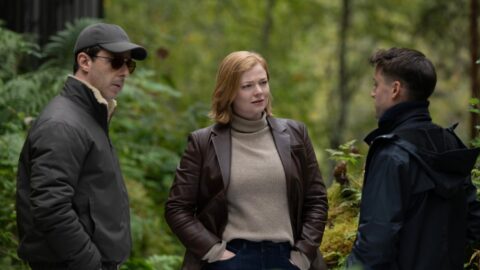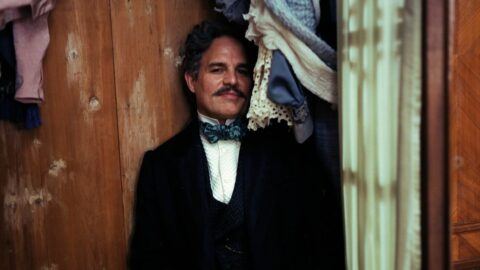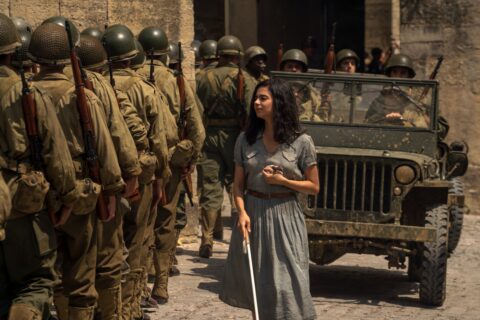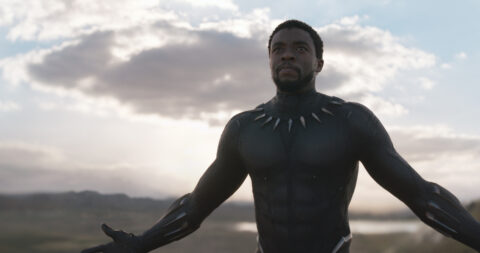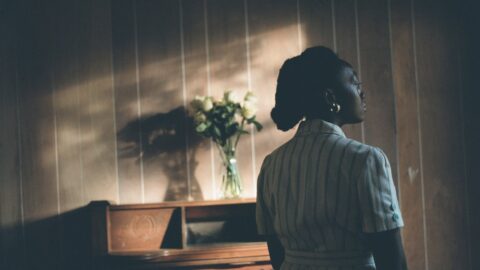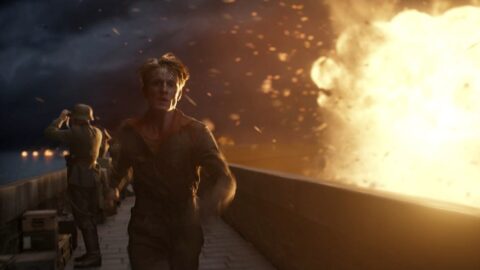The nominees for the 2024 Golden Globes are here and ____ dominated.
25 best movies of 2023, and where to watch them
The best movies of 2023 include “Beau Is Afraid,” “M3GAN,” “Are You There God? It’s Me, Margaret,” “Polite Society,” “Nimona,” “Rye Lane,” “Bottoms,” “Barbie,” “Ferrari,” and more.
Willem Dafoe and Mark Ruffalo reveal their intense physical transformations in ‘Poor Things’
Willem Dafoe and Mark Ruffalo discuss how the right makeup and costume can give you everything you need to tap into character or throw you off your game.
‘Poor Things’ review: Emma Stone and Mark Ruffalo deliver a horny-as-hell spin on ‘Frankenstein’
Yorgos Lanthimos gives us a surprisingly sweet comedy with “Poor Things,” starring Emma Stone and Mark Ruffalo. Review.
Hollywood strikes: Every movie that’s been pushed back
As the AMPTP refuses to negotiate with the striking SAG-AFTRA, films like “Challengers” and “Bikeriders” have been pushed back.
‘The Marvels’ teases a Young Avengers team-up — here’s how
“The Marvels” promises the start of the Young Avengers, which would include Kamala Khan, Kate Bishop, and Cassie Lang.
All Marvel Cinematic Universe movies ranked worst to best
Since 2008’s “Iron Man,” there have been dozens of movies in the Marvel Cinematic Universe. The latest? “The Marvels.” We rank the best to worst of the MCU.
‘All Dirt Roads Taste of Salt’ review: Raven Jackson’s feature-length debut is a beautiful, languid coming-of-age story
Writer/director Raven Jackson’s feature-length debut, “All Dirt Roads Taste of Salt,” tells the story of a young woman growing up in Mississippi. Review.

If I had to describe All Dirt Roads Taste of Salt in one word, it would be “lingering.”
The feature-length debut from filmmaker and poet Raven Jackson takes its time in all things. It fixates on quiet moments, sometimes for minutes on end. It pokes at the ways in which memories can surface long after we’ve experienced them. Finally, it stays in the mind long after you’ve seen it, even if you struggle with its languid pacing.
What is All Dirt Roads Taste of Salt about?

Credit: A24
All Dirt Roads Taste of Salt transports us to Mississippi in the 1970s and 1980s, where a young Black woman named Mackenzie — Mack for short — comes of age. Four actors play Mack across the span of her life: Mylee Shannon is Mack as a toddler, Kaylee Nicole Johnson is adolescent Mack, Charleen McClure is Mack from her late teens to her thirties, and Zainab Jah is a somewhat older Mack. The film weaves between these four life stages but mostly focuses on those embodied by Johnson and McClure.
Mack’s life unfurls before us in a series of nonlinear vignettes. She goes fishing with her father, Isaiah (Chris Chalk), and observes her mother, Evelyn (Sheila Atim), as she applies lipstick. She finds first love, only to lose it. She endures grief, becomes a mother herself, and remains steadfastly connected to her family. Her story is almost entirely devoid of dialogue — instead, Jackson finds meaning in silence and sensory experiences.
All Dirt Roads Taste of Salt is a deeply sensory film.

Credit: A24
With such an evocative title, it’s no surprise that All Dirt Roads Taste of Salt immerses itself in the senses. Lush soundscapes of chirping insects and falling rain envelop you in the muggy heat of Mississippi. The film’s very first image is an extended shot of young Mack running a finger over a fresh-caught fish, taking in every ridge of its scales. Not long after, she’ll dip her hands in the river mud and squeeze until it drips through her fingers.
Based on these opening scenes alone, you can tell that All Dirt Roads Taste of Salt is a film of textures. Jackson and cinematographer Jomo Fray are fascinated by how characters tangibly interact with their environment, focusing on bare feet treading over grass and hands digging through dirt. To watch these scenes is to feel the ghost of mud and grass on your own skin, to feel more aware of your own body in space overall.
‘Poor Things’ review: Emma Stone and Mark Ruffalo deliver a horny-as-hell spin on ‘Frankenstein’
The environment surrounding Mack is not just a place, but a deep-rooted part of her family’s lives and culture. As Mack’s Grandma Betty (Jannie Hampton) tells Mack and her sister, Josie (Moses Ingram), they’re all made of dirt and water. Repeated shots of rivers and rain, of mud and dry clay emphasize this granule of wisdom passed from generation to generation.
These all crystallize in the film’s exploration of the practice of geophagia, or eating earth. Geophagia is an old tradition, one that came to the United States from Africa through the transatlantic slave trade. The practice continues today, primarily in the south, and in All Dirt Roads Taste of Salt, we see that it is especially meaningful to Mack and other Black women in her family. When she or other characters eat clay dirt, it feels like a way to connect to those who came before, be they mothers, grandmothers, or ancestors even further back in the family line.
All Dirt Roads Taste of Salt is an unconventional meditation on memory.

Credit: A24
Jackson’s focus on memory and family connections is supported by the film’s hazy, dreamlike quality. The narrative flits from scene to scene, sometimes crossing decades in the process. Yet even if these moments take place years apart, Jackson manages to find the strange and beautiful ways in which they’re related. In one scene, a pregnant Mack lies in her bathtub — in the next, we see Evelyn bathing Mack as a toddler in the very same tub. There’s a circularity to it all, as if Jackson is eschewing linear time itself.
This slower, circular pacing allows for some thematically resonant parallels between stages in Mack’s life, but it can also prove challenging — even frustrating, at times. Beyond one scene where an older Mack (Jah) reflects by the river, there are few anchor points in the present that offer context for the memories Mack is processing. There is little sense of build-up in this film, only of events simply happening and then moving on. This is not to say these events happen in a vacuum: Mack’s memories are always in conversation with themselves. However, these conversations don’t necessarily have much to say. They simply exist.
All Dirt Roads Taste of Salt also struggles with its relationship to silence. Scenes that start out naturally quiet, like a melancholy parting hug between Mack and her ex-boyfriend, Wood (Reginald Helms Jr.), stretch on to the point of strangeness, bogged down by a continued silence that doesn’t always feel earned. In the aforementioned scene, the hug itself lasts for around five minutes, its original intimacy slowly devolving into grating repetition. When the film’s dialogue does come, it is both naturalistic and deeply evocative, even more than the lengthy silences that take up most of the film. If only the characters had more chances to really dig into a spoken scene.
While Jackson’s experimentation with narrative structure and rhythm sometimes falters, the overall beauty and deeply felt emotion of All Dirt Roads Taste of Salt are undeniable. With her feature-length debut, Jackson has crafted a sensitive coming-of-age film, one that doubles as a hyper-specific portrait of the woods and fields and rivers that shaped Mack and her whole family. After all, the truest scenes here are always those shared between humans and nature: Mack and her father fishing in a muddy riverbed, Mack and her daughter letting rainwater trickle down their arms, Mack’s grandmother telling Mack and Josie about clay dirt eating. In these moments, Jackson and the film’s magic truly come together, making for a perfect storm of memory, family, and the places that shape us.
All Dirt Roads Taste of Salt opens in theaters Nov. 3.
UPDATE: Oct. 31, 2023, 1:40 p.m. EDT All Dirt Roads Taste of Salt was reviewed out of the New York Film Festival; the movie opens in theaters Nov. 3.
Review: ‘All the Light We Cannot See’ is a sweet, if heavy-handed, series
Based on Anthony Doerr’s novel, “All the Light We Cannot See” is a Netflix series about two young people in World War II. It releases November 2.

August, 1944. American aircraft bomb the Nazi-occupied French city of Saint-Malo. In a townhouse, a blind girl reads Jules Verne over a radio broadcast, waiting for her great-uncle and father to come home. Not far from her, in an upscale hotel-turned-fortress, a German soldier listens to her words. Their lives are inextricably connected and are about to become even more so, but as the bombs rain down, they are unaware of the forces that tie them together.
So begins Netflix’s All the Light We Cannot See, opening in near-identical fashion to Anthony Doerr’s Pulitzer Prize-winning novel on which it is based. Spanning years and much of the European continent, Doerr’s novel is a densely layered war epic. Cursed gems, radio technology, and secret codes all play a part within its many, many pages.
Given the novel’s heft and immense popularity, adapting it for the screen presents a tricky challenge — one that director Shawn Levy (Stranger Things, Free Guy) and screenwriter Steven Knight (Peaky Blinders, Serenity) mostly rise to meet. The four-part limited series is unable to replicate Doerr’s lyrical prose, resulting instead in some fairly heavy-handed dialogue. However, it more than makes up for that shortcoming with its genuine earnestness and high-quality production, which results in an adaptation that is cinematic and sweet in equal measure.
All the Light We Cannot See is part war story, part coming-of-age tale.

Credit: Netflix
While All the Light We Cannot See opens with a boy and a girl weathering the bombing of Saint-Malo, there are several years’ worth of story leading us to that point. The series winds back the clock to explore each character’s childhood, using the events in Saint-Malo as a framing device. Notably, the series spends far more time in Saint-Malo than in the past: one of the many changes Knight’s adaptation makes from original book. However, the chronological back-and-forth recalls the structure of Doerr’s novel, all while creating a sense of inevitability: Everything in the boy’s and girl’s lives has been leading to these fateful few days in Saint-Malo.
The girl is Marie-Laure LeBlanc (Aria Mia Loberti). Before Saint-Malo, she lives in Paris with her father Daniel (Mark Ruffalo), the master locksmith at the Museum of Natural History. He makes her a scale model of their neighborhood to help her learn its roads by touch, and he tells her about the many wonders of the Museum. One such wonder is the famed jewel known as the Sea of Flames. Legend has it that whoever possesses it will live forever, but that their loved ones will suffer great misfortune. (The greatest misfortune that Marie’s portion of All the Light We Cannot See suffers are the British accents put on by all these supposedly French characters. A common trait in period movies, I know, but an aggravating one nonetheless.)
Luckily, what these scenes lack in accent realism (charming as he is, Ruffalo’s is extra shaky), they make up for in whimsy, whether that’s Daniel teaching a young Marie (Nell Sutton) how to use the Paris model or Marie listening to illuminating radio broadcasts from a figure known simply as “the professor.” Even when the Nazis’ invasion of Paris forces Marie and Daniel to flee to Saint-Malo to live with Daniel’s Uncle Etienne (Hugh Laurie), Marie seeks out the professor’s broadcast wherever she can.
The boy listens to the professor, too. He is Werner Pfennig (Louis Hofmann), a German orphan who’s a whiz at building and fixing radios. His genius catches the eye of an elite Nazi academy, where Werner faces unspeakable cruelty. The only things that keep him believing in the good of humanity, even as he’s sent on missions to eliminate illegal radio transmissions, are the professor’s words of guidance and kindness. Nations apart, both Werner and Marie look to those words as lifelines to hang on to as the world grows dark around them.
Marie and Werner’s discussions of light and darkness can tend towards being too on-the-nose, especially when you’ve heard variations of them over and over again. However, both Loberti and Hofmann wear their hearts on their sleeves, each performer creating a portrait of hopeful, clear-eyed youth. It helps that both actors are relative unknowns to U.S. audiences. Hofmann is most recognizable for his work in the German series Dark, while Loberti is a complete newcomer. Their takes on Marie and Werner shine throughout the series, and while they rarely share the screen, All the Light We Cannot See makes sure to draw parallels between their resourcefulness, kindness, and perseverance.
All the Light We Cannot See is a feast for the senses.

Credit: Netflix
In addition to the strength of its two leads, All the Light We Cannot See benefits from a beautifully realized world. While much of the series was shot in Budapest and Villefranche-de-Rouergue, exterior shots of the real Saint-Malo help ground us in the city, from its narrow streets to its massive wall extending along the sea.
All the Light We Cannot See also relishes in the tactile — a choice that drops us right into Marie’s point of view, as touch is one of the primary ways in which she navigates the world. We watch young Marie examine the nooks and crannies of the wooden Paris model with her hands, and later reach for familiar touchstones in Etienne’s house, like banisters or tables and chairs. Thanks to this focus on texture, we become extra receptive to everything from bomb shrapnel to the rubble-strewn across Saint-Malo.
Equally captivating is the show’s use of that all-important titular light. Whether it’s the sun’s golden rays diffusing through a room or a campfire keeping the darkness at bay, light is everywhere in All the Light We Cannot See. The show’s nighttime scenes in particular make for a much-needed antidote to the majority of overly dim night scenes in film and TV today. Here, crisp shadows and blue hues win out over shapeless darkness. (Fitting, given the show’s many speeches about how light always overcomes the dark.) A sequence in which sinister Nazi gemologist von Rumpel (Lars Eidinger) hunts Marie through a darkened grotto is especially representative of this feat. It establishes the presence of light through the reflection of the moon on the water and the explosion of bombs outside — a juxtaposition of natural beauty and wartime horror in full effect.
That same dichotomy between beauty and the horrors of war runs throughout All the Light We Cannot See. The Sea of Flames is a stunning gem, shining as if lit from within, yet its supposed curse — and von Rumpel’s dogged obsession — make it more of a danger than something to be treasured. James Newton Howard’s soaring score contrasts with the whistles and explosions of bombs and artillery. But the most prominent source of duality in All the Light We Cannot See is none other than the radio. Nazi officers and French resistance members alike refer to the radio as a tool of war, but for Marie and Werner, it’s a means to connect with others and to feel less alone during a time of great strife. The latter is the path All the Light We Cannot See emphasizes again and again, rejecting any cynicism in favor of bringing an optimistic message to beautiful, blinding light.
All the Light We Cannot See premieres on Netflix Nov. 2.
UPDATE: Oct. 31, 2023, 11:24 a.m. EDT All the Light We Cannot See was reviewed out of its world premiere at 2023’s Toronto International Film Festival.
